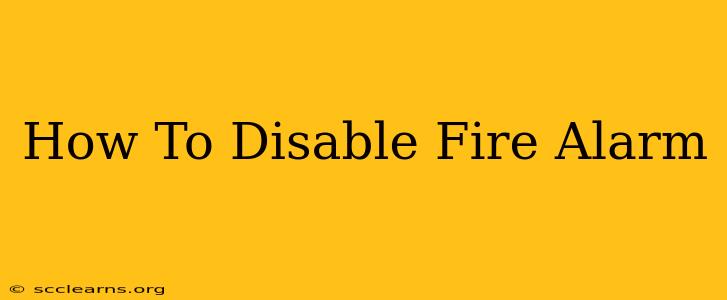Disclaimer: This guide provides information on temporarily silencing a fire alarm. Never permanently disable a fire alarm without the proper authorization and understanding of the implications. Failing to maintain functional fire alarms can have serious legal and safety consequences. Always prioritize safety and consult qualified professionals for any concerns or issues with your fire alarm system.
Understanding Your Fire Alarm System
Before attempting to silence your fire alarm, it's crucial to understand what type of system you have. There are several types, including:
- Standard Smoke Alarms: These are usually battery-powered or hardwired and detect smoke.
- Heat Alarms: These activate when the temperature reaches a certain level.
- Combination Smoke and Heat Alarms: These offer dual protection.
- Interconnected Systems: These systems have multiple alarms linked together; if one sounds, they all sound.
Understanding your system is essential for proper deactivation.
Why Might You Need to Temporarily Silence a Fire Alarm?
There are legitimate reasons you might need to temporarily silence a fire alarm, but always prioritize safety. These reasons might include:
- Burning Food: A minor kitchen fire that you can safely extinguish. Never leave a cooking fire unattended.
- Dust or Steam: Excessive dust or steam can trigger a false alarm.
- Maintenance or Testing: You might need to temporarily silence the alarm while performing maintenance or testing.
- Construction or Renovation: Work involving dust or debris might trigger the alarm.
How to Temporarily Deactivate a Fire Alarm
The method for silencing a fire alarm depends on the type of alarm.
Battery-Powered Smoke Alarms:
- Locate the Hush Button: Most battery-powered smoke alarms have a small button labeled "Hush," "Test," or a similar designation.
- Press and Hold: Press and hold this button for the time specified in the alarm's instructions (usually around 10-15 seconds).
- Alarm Silencing: The alarm should silence. However, the underlying cause of the alarm should be addressed.
Important: A temporary silence function does not address the issue causing the alarm. If the alarm continues to activate repeatedly, there's an ongoing problem that needs immediate attention.
Hardwired Smoke Alarms:
Hardwired alarms often require more specialized methods of silencing. These might include a dedicated control panel or the assistance of a qualified electrician or fire alarm technician. Do not attempt to disable a hardwired system without professional help.
Interconnected Systems:
In interconnected systems, silencing one alarm might not silence the others. You might need to locate the main control panel or contact a professional.
Safety Precautions
- Never disable a fire alarm permanently without professional assistance.
- Always investigate the cause of the alarm before silencing it. A false alarm could indicate a real threat.
- Always test your alarms regularly (at least monthly) to ensure proper functionality.
- Replace batteries in battery-powered alarms regularly.
- Schedule regular professional inspections of your fire alarm system.
- Know your local fire codes and regulations.
When to Call a Professional
If you're unsure about any aspect of your fire alarm system or have any concerns, always contact a qualified fire alarm technician or electrician. It's better to be safe than sorry. Your safety and the safety of others is paramount. Ignoring fire alarm issues can have dangerous consequences.

